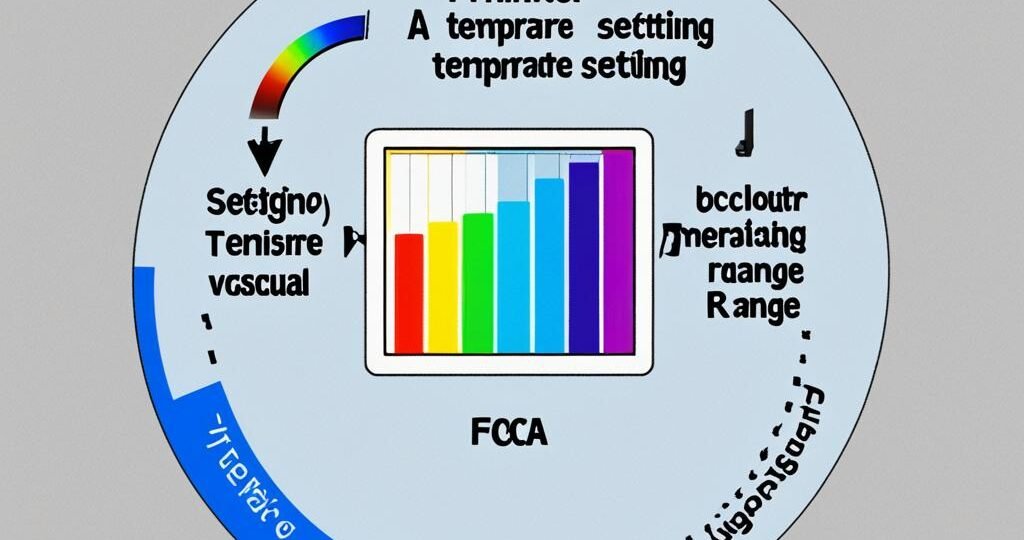
When it comes to 3D printing, setting the right print temperature is crucial for achieving optimal results. The temperature settings for both the print bed and the extruder can greatly impact the quality and precision of your prints. In this comprehensive guide, we will explore the ideal temperature ranges for different filament materials, such as PLA and PETG, and provide tips for calibrating and optimizing your print temperatures.
Support us at www.devilndove.com or our store at www.devilndove.online.
Key Takeaways:
- Understanding the thermal properties of filament materials is essential for setting the right print temperature.
- Calibrating and optimizing your print temperatures can improve the quality and precision of your 3D prints.
- Troubleshooting temperature-related issues with PLA and other materials requires adjusting the print and bed temperatures.
- Experimentation and testing are key to finding the optimal temperature range for your specific setup and filament brand.
- Proper temperature settings can ensure optimal adhesion, reduce print defects, and produce high-quality prints.
Understanding PLA Bed Temperature and Print Temperature
When it comes to 3D printing with PLA filament, finding the perfect balance between the bed temperature and the print temperature is essential for achieving high-quality prints. However, determining the ideal PLA bed temperature and print temperature can be a bit tricky, as it can vary depending on factors such as the brand of filament and the type of 3D printing hardware being used.
Before diving into the specifics, let’s first understand the thermal properties of PLA. PLA (polylactic acid) has a glass transition temperature of around 60 degrees Celsius, which is the temperature at which the material transitions from a rigid, glass-like state to a softer, more flexible state. The melting temperature of PLA ranges from 150 to 160 degrees Celsius, at which point the material becomes fully molten and suitable for extrusion.
Now, let’s talk about the importance of a heated print bed. While PLA can be printed without a heated print bed, using one offers several advantages. A heated print bed helps improve adhesion between the first layer of the print and the build surface, reducing the chances of warping or detachment during the printing process. It also promotes better overall print quality by ensuring consistent heat distribution throughout the print.
In low-temperature printing, where the print bed temperature is kept below the glass transition temperature of PLA, the material remains in a rigid state, making it more prone to detachment and warping. By heating the print bed, we can elevate the PLA bed temperature to a point where the first layer adheres more effectively, resulting in better print quality and successful prints.
Example of Heating PLA Print Bed vs Non-Heated Print Bed:
| Print Bed Temperature | Results |
|---|---|
| 40°C (Non-Heated) | Higher chances of warping and poor adhesion |
| 60°C (Heated) | Better adhesion and reduced warping |
| 80°C (Heated) | Optimal adhesion and minimal warping |
As seen in the table above, a heated print bed significantly improves the adhesion of the PLA material, leading to better print quality and minimizing the risk of warped or failed prints.
“Using a heated print bed with PLA can greatly enhance your 3D printing experience, ensuring successful prints and reducing the frustration caused by failed or warped parts.”
Keep in mind that the ideal PLA bed temperature can vary depending on the specific brand of filament being used. Manufacturers often provide recommended PLA bed temperature settings based on their specific materials. It is essential to refer to these guidelines and make any necessary adjustments to achieve optimal adhesion and print quality.
Next, we will explore recommended PLA bed temperature settings from reputable filament brands such as MatterHackers, Fillamentum, and Ultimaker, as well as discuss the importance of selecting the right build surface for optimal adhesion and print quality.
Support us at www.devilndove.com or our store at www.devilndove.online.
Recommended PLA Bed Temperature Settings
When it comes to 3D printing with PLA, setting the right bed temperature can greatly impact the quality of your prints. While PLA can be printed without a heated bed, using one can provide certain benefits such as improved first-layer adhesion and reduced warping. The recommended PLA bed temperature varies depending on the specific filament brand, but generally falls within the range of 40 to 60 degrees Celsius.
Material manufacturers like MatterHackers, Fillamentum, and Ultimaker suggest specific PLA bed temperature settings for their filaments:
| Brand | Recommended PLA Bed Temperature (°C) |
|---|---|
| MatterHackers Build Series PLA | 50-60 |
| Fillamentum Extrafill PLA | 45-55 |
| Ultimaker PLA | 40-50 |
In addition to the bed temperature, the choice of build surface also plays a crucial role in achieving optimal PLA bed adhesion. Some popular options for build surfaces include glass coated with adhesive or a properly calibrated bed level.
By following the recommended PLA bed temperature settings and choosing the appropriate build surface, you can enhance the first-layer adhesion and minimize the risk of warping, resulting in successful and high-quality 3D prints.
Understanding Ideal PLA Print Temperature
When it comes to 3D printing with PLA filament, finding the ideal PLA print temperature is crucial for achieving high-quality results. PLA prints best at a moderate temperature, typically around 210 degrees Celsius. This low print temperature is due to PLA’s relatively low glass transition temperature of around 60 degrees Celsius.
However, the optimal PLA print temperature can vary depending on several factors, including the specific filament variety, printing speed, and nozzle size. It is important to find the right balance to ensure proper material flow and interlayer bonding without causing issues like part deformation or oozing.
To determine the ideal PLA print temperature, consider the following:
- Filament Variety: Different PLA brands and formulations may have slightly different optimal print temperatures. It is recommended to check the manufacturer’s guidelines for the filament you are using.
- Printing Speed: Higher printing speeds may require slightly higher nozzle temperatures to ensure filament flow and proper layer adhesion. Experiment with different temperatures to find the optimal balance between speed and print quality.
- Nozzle Size: The size of your nozzle can also impact the ideal PLA print temperature. Smaller nozzles may require lower temperatures to prevent clogs, while larger nozzles may benefit from slightly higher temperatures to improve material flow.
By fine-tuning these variables, you can optimize your nozzle temperature to achieve exceptional print quality with PLA filament.
Recommended PLA Print Temperature Settings
| Filament Brand | Ideal PLA Print Temperature (°C) |
|---|---|
| MatterHackers Build Series PLA | 205-225 |
| Fillamentum Extrafill PLA | 200-220 |
| Ultimaker PLA | 205-215 |
Keep in mind that these temperature ranges are general recommendations and may vary based on your specific printing setup and preferences. It is always a good idea to perform test prints and adjust the temperature settings as needed to achieve the desired results.
With a proper understanding of the ideal PLA print temperature and careful temperature optimization, you can enjoy seamless 3D prints with PLA filament and bring your creative ideas to life.
Support us at www.devilndove.com or our store at www.devilndove.online.
Print Enclosure Considerations for PLA
While PLA generally does not require a print enclosure due to its low temperature requirements and non-toxic fumes, there are certain considerations to keep in mind if using one.
Using a print enclosure with PLA can potentially cause issues such as nozzle jams, softening of delicate areas, and part failure. However, some researchers have found success using environmentally controlled enclosures for printing PLA.
Pros and Cons of Using a Print Enclosure
- Pros:
- Provides a controlled printing environment
- Reduces the impact of external factors like drafts and temperature variations
- Can improve print quality and accuracy
- Cons:
- Potential for nozzle jams due to increased temperatures
- Softening of delicate areas, leading to deformation
- Possible part failure due to higher ambient temperatures
When using a print enclosure, it is crucial to monitor the enclosure temperature closely to avoid these issues. Maintaining a stable and appropriate enclosure temperature is key to successful PLA printing.
Tips for Avoiding Potential Problems
- Monitor the enclosure temperature: Use a thermometer or temperature controller to ensure the temperature remains within the optimal range for PLA printing.
- Avoid excessive temperatures: PLA has a low melting point, so it is essential to prevent the enclosure temperature from exceeding the recommended printing temperature to avoid softening or deformation of the printed parts.
- Ensure proper ventilation: While PLA is generally non-toxic, it is still essential to maintain adequate ventilation in the print enclosure to prevent any buildup of fumes or odors.
- Optimize cooling: Consider adding a cooling fan or ventilation system to prevent overheating of the print enclosure and to provide adequate cooling for the printed parts.
Using an environmentally controlled enclosure for PLA printing can provide better control over the printing environment and potentially improve print quality. However, it is crucial to be aware of the potential challenges and take necessary precautions to avoid issues like nozzle jams, part failure, and softening of delicate areas.
By following these considerations and tips, you can increase the chances of successful 3D printing with PLA in an enclosed environment.
Support us at www.devilndove.com or our store at www.devilndove.online.
Troubleshooting Temperature-related Issues with PLA
Temperature-related issues can be a common challenge when working with PLA filament. Incorrectly set PLA bed temperature or print temperature can lead to various problems that can affect the quality and success of your 3D prints. Understanding these temperature-related issues and knowing how to troubleshoot them is essential for achieving optimal results. In this section, we will explore some of the most common temperature-related issues with PLA and provide helpful tips on how to diagnose and resolve them.
1. Elephant’s Foot
One temperature-related issue you may encounter is known as “elephant’s foot.” This occurs when the first layers of your print spread out, resulting in a wider bottom surface. Elephant’s foot can be caused by printing at a too high PLA bed temperature, causing excessive material flow and adhesion to the print bed. To troubleshoot this issue, try reducing the PLA bed temperature slightly and adjusting the first-layer height to ensure proper adhesion without excessive material spreading.
2. Over-adhesion
Over-adhesion, or parts sticking too firmly to the print bed, can also be a temperature-related issue. If you notice that your prints are difficult to remove or leave residue on the print bed, it may indicate that the PLA bed temperature is too high. Lowering the PLA bed temperature and applying a suitable print bed surface, such as build tak or painter’s tape, can help achieve the right balance between adhesion and ease of removal.
3. Heat Creep
Heat creep is a phenomenon in which filament melts outside of the nozzle and travels up the heat break, leading to clogging and poor extrusion. While not directly related to PLA bed temperature, it can be caused by insufficient cooling or excessive PLA print temperature. To troubleshoot heat creep, ensure that your printer’s cooling system is functioning properly and consider lowering the PLA print temperature to reduce heat transfer up the heat break.
4. Sagging
Sagging, or drooping, during printing can be another temperature-related issue. It typically occurs when the PLA print temperature is too high, causing the layers of the print to lose their shape and distort. Lowering the PLA print temperature and ensuring proper cooling can help prevent sagging and maintain the structural integrity of your prints.
5. Oozing and Stringing
Oozing and stringing refer to the excessive leakage and thin strands of filament between printed parts or areas of a print. These issues are typically caused by a high PLA print temperature and improper retraction settings. Adjusting the PLA print temperature to the lower end of the recommended range and fine-tuning the retraction settings, such as retraction distance and speed, can help minimize oozing and stringing.
6. Poor Adhesion
Poor adhesion between layers or a lack of bonding can also be a temperature-related issue when printing with PLA. If you notice that your layers are not sticking together well, it may indicate that the PLA print temperature is too low. Increasing the PLA print temperature can improve interlayer bonding and overall print strength.
By understanding these temperature-related issues and knowing how to troubleshoot them, you can overcome common challenges when printing with PLA. Tinkering with the PLA bed temperature, print temperature, and retraction settings can help you achieve optimal results and improve the overall quality of your 3D prints.
You can find more tips and tricks on optimizing your PLA 3D prints and troubleshooting temperature-related issues at our website, devilndove.com, or visit our online store at devilndove.online to explore a wide range of 3D printing products and materials.
Conclusion
Finding the optimal print temperature is crucial for achieving high-quality 3D prints with precision and excellent results. Throughout this guide, we have explored the importance of understanding the thermal properties of different filament materials, such as PLA, and the significance of calibrating both the print and bed temperatures.
By conducting experiments and tests, you can determine the ideal temperature range for your specific setup and filament brand, ensuring optimal adhesion and reducing print defects. Fine-tuning the temperature settings not only enhances the overall print quality but also plays a key role in producing accurate and detailed prints.
Remember, precision and quality in 3D printing can be achieved through temperature calibration. Whether you’re a beginner or an experienced enthusiast, optimizing the print temperature is a continuous process that requires patience and attention to detail. With the right temperature settings, you can unleash the full potential of your 3D printer and create impressive prints.
Support us at www.devilndove.com or browse our store at www.devilndove.online for further guidance, resources, and high-quality 3D printing supplies. Start your journey towards unparalleled precision and exceptional print quality today!
FAQ
How important is setting the right print temperature for 3D printing?
Setting the right print temperature is crucial for achieving optimal results in 3D printing. It greatly impacts the quality and precision of your prints.
What is the recommended PLA bed temperature range?
The recommended PLA bed temperature varies depending on the specific filament brand, but generally falls within the range of 40 to 60 degrees Celsius.
What is the optimal print temperature for PLA?
PLA prints best at a moderate temperature, typically around 210 degrees Celsius.
Do I need a heated print bed for printing PLA?
While PLA can be printed without a heated print bed, using one can provide benefits such as improved first-layer adhesion and reduced warping.
Can I use a print enclosure with PLA?
While PLA generally does not require a print enclosure, using one has pros and cons. It can potentially cause nozzle jams and part failure but can be successful with environmental control.
What temperature-related issues can occur with PLA?
Temperature-related issues with PLA can include elephant’s foot, over-adhesion, heat creep, sagging, and oozing or stringing.
How can I troubleshoot temperature-related issues with PLA?
Troubleshooting temperature-related issues with PLA often involves adjusting the bed temperature, print temperature, or retraction settings.
How can I optimize my 3D printing process with the right temperature settings?
By understanding the thermal properties of different filament materials, such as PLA, and calibrating the print and bed temperatures, you can optimize your 3D printing process for high-quality prints.
Source Links
RELATED POSTS
View all



